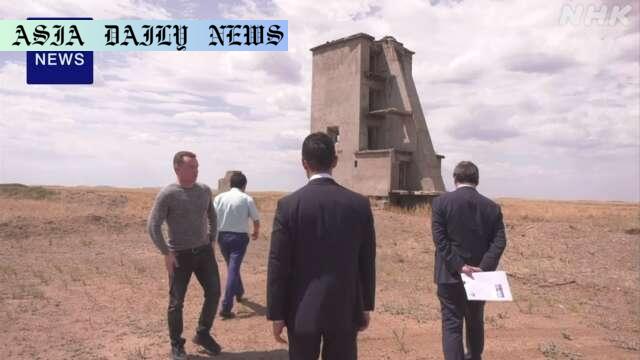Nuclear Testing: Governor Yuzaki Hidehiko of Hiroshima visited a former Soviet nuclear testing site to strengthen nuclear elimination efforts.

Governor Yuzaki’s Visit to Kazakhstan: A Commitment to Nuclear Disarmament
Governor Yuzaki Hidehiko of Japan’s Hiroshima Prefecture has undertaken a meaningful journey, marking a new chapter in the shared fight against nuclear weapons. By visiting the former Semipalatinsk nuclear testing site in Kazakhstan, Governor Yuzaki establishes a symbolic collaboration between Hiroshima, a victim of atomic bombing, and Kazakhstan, a nation deeply scarred by decades of Soviet nuclear testing. He aims to strengthen global connectivity in pursuing nuclear disarmament by understanding the profound effects of nuclear weapons testing firsthand.
The governor’s visit included a tour of the museum situated in Kurchatov city, next to the sprawling testing grounds. The museum stands as a testament to the devastating scientific legacy of Soviet nuclear experiments, conducted between 1949 and 1989. Over 450 nuclear tests were carried out on this vast expanse of 18,000 square kilometers, leaving deep scars on the land and its people. The effects of these tests resonate even today, with radioactive contamination affecting the health of approximately 1.5 million people in the region.
Insights into the Observations of Nuclear Events
One of the significant locations visited by Governor Yuzaki was a four-story concrete observation station used during the Soviet testing period. These stations, strategically positioned from the nuclear test hypocenters, served as crucial facilities where Soviet scientists recorded data on nuclear detonations. Through exhibits at the museum, the governor learned how observation stations captured images of nuclear explosions while gathering key information on radiation levels and blast impacts.
The Human Impact of Nuclear Testing
Governor Yuzaki’s visit extends beyond historical narratives to address the grave health challenges faced by those in and around the former Semipalatinsk testing site. Radiation exposure resulted in genetic disorders, cancers, and widespread chronic illnesses, significantly impacting the quality of life for generations. The museum tour was complemented by meetings with individuals directly affected by radiation exposure, providing personal and emotional perspectives on the issue. Governor Yuzaki listened intently to these survivors, fostering a sense of mutual sympathy and commitment between Hiroshima and Kazakhstan.
Hiroshima’s Role in Promoting a Nuclear-Free Future
This historic visit underscores Hiroshima’s role as a beacon in the anti-nuclear movement. Governor Yuzaki’s engagement resonates with Hiroshima’s enduring mission to eradicate nuclear weapons globally. Through dialogue, education, and collaboration with other nations, such as Kazakhstan, Hiroshima seeks to prevent nuclear tragedies from repeating in the future. By building bridges with locations affected by nuclear weaponry, Yuzaki aims to amplify the voice of those advocating for peace, safety, and the end of nuclear arms.
Conclusion: A Unified Call for Global Disarmament
Governor Yuzaki’s trip to Kazakhstan represents a resolute commitment to advancing the global anti-nuclear agenda. The visit demonstrates the spirit of unity between Hiroshima and nations like Kazakhstan that continue to deal with the legacy of nuclear weapons. This collaborative effort seeks to educate and inspire future generations worldwide to embrace peace and work tirelessly toward the abolition of nuclear weapons. The Hiroshima governor’s journey is a powerful reminder of humanity’s collective responsibility to learn from the past and create a safer, more secure world free from the threat of nuclear devastation.
Commentary
Recognizing the Human Cost of Nuclear Testing
Governor Yuzaki’s visit to Kazakhstan serves as a poignant reminder of the devastating human cost associated with nuclear weapons testing. While Hiroshima endures as a somber symbol of atomic destruction, the Semipalatinsk testing site offers a chilling parallel, demonstrating the long-lasting consequences of relentless nuclear experiments. The stories of those affected by the fallout in Kazakhstan, combined with the suffering endured by Hiroshima’s hibakusha, strengthen a global narrative that underscores the urgency of nuclear disarmament.
Fostering Collaboration for a Nuclear-Free World
One of the most compelling aspects of this visit is the effort to forge international bonds between Hiroshima and regions impacted by nuclear arms. The shared experiences of loss, grief, and recovery create a deep sense of solidarity that transcends borders. Governor Yuzaki’s initiative is a powerful gesture that connects nations through their tragedies while galvanizing them to advocate for meaningful, impactful change on a global scale.
The Role of Education in Preventing Future Tragedies
Highlighting the historical and ongoing consequences of nuclear testing highlights the critical need for education. The museum in Kurchatov and institutions in Hiroshima are instrumental in keeping the memory of these tragedies alive, educating generations about the dire consequences of nuclear proliferation. Governor Yuzaki’s visit emphasizes the importance of such institutions in not only commemorating the past but also shaping public awareness and fostering an informed push toward global peace.
Final Thoughts: A Hopeful Vision for Peace
This unique collaboration serves as a vital step in the global struggle against nuclear armament. With leaders like Governor Yuzaki championing disarmament and inspiring future collaborations, there is hope on the horizon for a world where such devastation becomes a relic of history. The combined legacies of Hiroshima and Kazakhstan must serve as a beacon, urging humanity to pursue peace and reject instruments of mass destruction.


